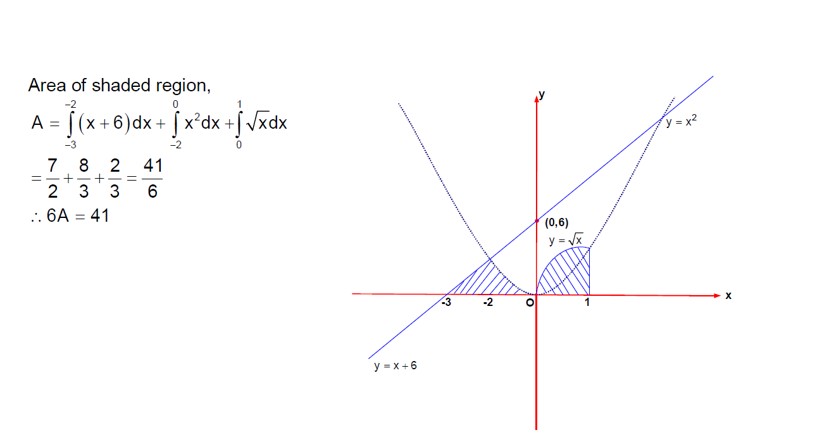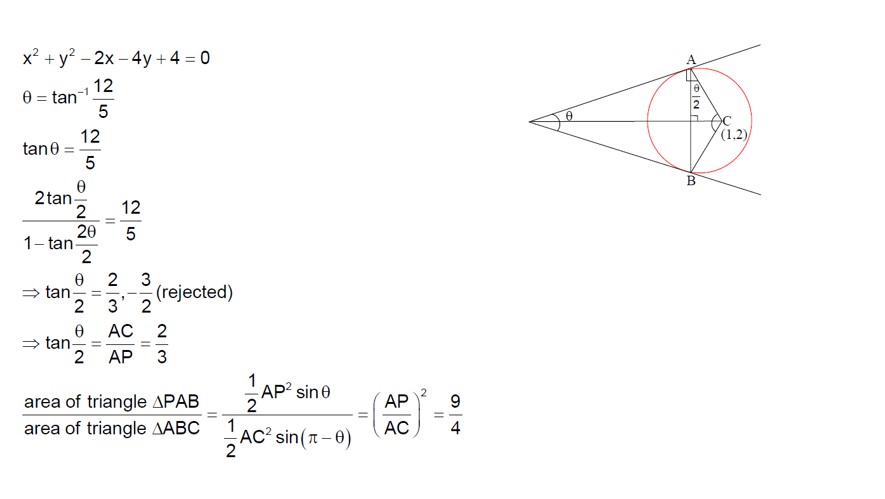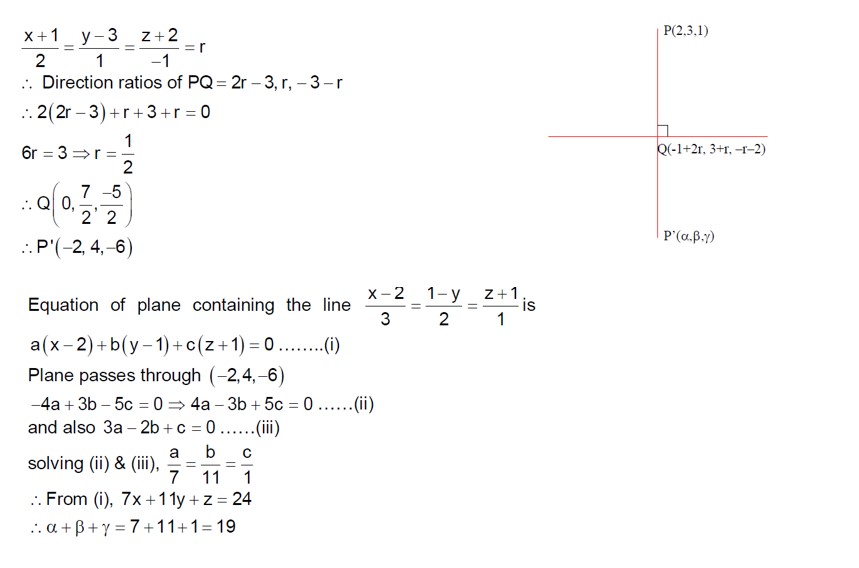Ncert Solutions Maths class 12th
Get insights from 2.5k questions on Ncert Solutions Maths class 12th, answered by students, alumni, and experts. You may also ask and answer any question you like about Ncert Solutions Maths class 12th
Follow Ask QuestionQuestions
Discussions
Active Users
Followers
New answer posted
2 months agoContributor-Level 10
P (x) = f (x³) + xg (x³) is divisible by x²+x+1. The roots of x²+x+1=0 are the complex cube roots of unity, ω and ω².
P (ω) = f (ω³) + ωg (ω³) = f (1) + ωg (1) = 0 — (I)
P (ω²) = f (ω²)³) + ω²g (ω²)³) = f (1) + ω²g (1) = 0 — (II)
Subtracting (II) from (I): (ω - ω²)g (1) = 0. Since ω ≠ ω², we must have g (1) = 0.
Substituting g (1)=0 into (I) gives f (1) = 0.
We need to find P (1) = f (1³) + 1*g (1³) = f (1) + g (1).
P (1) = 0 + 0 = 0.
New answer posted
2 months agoContributor-Level 10
The equation of a plane is determined by a point it passes through and a normal vector. The plane passes through (1, -6, -5). Its normal vector (a, b, c) is perpendicular to two other vectors, derived from the given equations:
4a - 3b + 7c = 0
3a + 4b + 2c = 0
The direction of the normal vector (a, b, c) is found by the cross product of (4, -3, 7) and (3, 4, 2):
a = (-3) (2) - 7 (4) = -34.
b = 7 (3) - 4 (2) = 13.
c = 4 (4) - (-3) (3) = 25.
So the plane equation is -34 (x-1) + 13 (y+6) + 25 (z+5) = 0.
The point (1, -1, α) lies on this plane:
-34 (1-1) + 13 (-1+6) + 25 (α+5) = 0.
0 + 13 (5) + 25α + 125 = 0.
65 + 25α + 125 = 0 ⇒ 25α = -190
New answer posted
2 months agoContributor-Level 10
The vector PQ is given by Q - P = (-3-1, 5-3, 2-a) = (-4, 2, 2-a).
This vector is collinear with 2i - j + k = (2, -1, 1).
This means their components are proportional: -4/2 = 2/ (-1) = (2-a)/1.
From -2 = 2-a, we find a=4.
The midpoint M of PQ is (-3+1)/2, (5+3)/2, (2+4)/2) = (-1, 4, 3).
M lies on the plane 2x - y + z - b = 0.
Substitute the coordinates of M: 2 (-1) - 4 + 3 - b = 0 ⇒ -2 - 4 + 3 = b ⇒ b = -3.
New answer posted
2 months agoContributor-Level 10
This is a binomial probability problem with n=5. Let p be the probability of success and q be the probability of failure.
Given P (X=1) =? C? p¹q? = 5pq? = 0.4096 — (I)
Given P (X=2) =? C? p²q³ = 10p²q³ = 0.2048 — (II)
Divide (I) by (II): (5pq? ) / (10p²q³) = 0.4096 / 0.2048 = 2.
(1/2) * (q/p) = 2 ⇒ q/p = 4 ⇒ q = 4p.
Using p+q=1, we have p+4p=1 ⇒ 5p=1 ⇒ p=1/5.
And q = 4/5.
We need to find P (X=3) =? C? p³q².
P (X=3) = 10 * (1/5)³ * (4/5)² = 10 * (1/125) * (16/25) = 160 / 3125 = 32 / 625.
New answer posted
2 months agoContributor-Level 10
The general term Tr+1 in the expansion of (a/x + x)^n (assuming from context, as it is not explicitly stated) is:
Tr+1 = nCr * (a/x)^r * x^ (n-r) = nCr * a^r * x^ (n-2r)
(The text shows (a/x^2) leading to x^ (n-3r)
Assuming the term is (x + a/x^2)^n:
Tr+1 = nCr * x^ (n-r) * (a/x^2)^r = nCr * a^r * x^ (n-3r)
T3 = T (2+1) = nC2 * a^2 * x^ (n-6)
T4 = T (3+1) = nC3 * a^3 * x^ (n-9)
T5 = T (4+1) = nC4 * a^4 * x^ (n-12)
The ratio of the coefficients is given:
(nC2 * a^2) / (nC3 * a^3) = 12/8 = 3/2
(n (n-1)/2) * a^2) / (n (n-1) (n-2)/6) * a^3) = 3/2
(3 / (n-2) * (1/a) = 3/2 => a (n-2) = 2 (i)
(nC3 * a^3) / (nC4 * a^4) = 8/3
(n (n-1) (n-2)/6) * a^3)
New answer posted
2 months agoContributor-Level 10
A relation R is defined as ARB if PAP? ¹ = B for a non-singular matrix P.
· Reflexive: ARA requires PAP? ¹ = A. This holds if P is the identity matrix I, as IAI? ¹ = A. Assuming P can be I, the relation is reflexive.
· Symmetric: We need to show that if ARB, then BRA.
ARB ⇒ PAP? ¹ = B.
To get the reverse, we need to express A in terms of B.
From PAP? ¹ = B, pre-multiply by P? ¹ and post-multiply by P:
P? ¹ (PAP? ¹)P = P? ¹BP ⇒ A = P? ¹BP. This shows BRA where the matrix is P? ¹. Thus, the relation is symmetric.
· Trans
New answer posted
2 months agoContributor-Level 10
Given f(x) = e^x sin(x).
Let F(x) = ∫[0 to x] f(t) dt.
By the Fundamental Theorem of Calculus, F'(x) = f(x) = e^x sin(x).
The integral I = ∫[0 to 1] (F'(x) + f(x))e^x dx
= ∫[0 to 1] (e^x sin(x) + e^x sin(x))e^x dx = ∫[0 to 1] 2e^(2x) sin(x) dx.
The text computes I = ∫[0 to 1] 2 sin(x) dx = [-2cos(x)] from 0 to 1 = -2cos(1) - (-2cos(0)) = 2(1 - cos(1)). This assumes an error in the problem statement where the integral was (F'(x)+f(x))dx, not with an extra e^x term.
Using the series expansion for cos(1) = 1 - 1/2! + 1/4! - .
2(1 - cos(1)) = 2(1 - (1 - 1/2 + 1/24 - .)) = 1 - 1/12 + . ≈ 11/12 ≈ 0.916.
The inequality 330/360 < I < 331/360 (i.e., 0.9166 < I < 0.9194) is checked
Taking an Exam? Selecting a College?
Get authentic answers from experts, students and alumni that you won't find anywhere else
Sign Up on ShikshaOn Shiksha, get access to
- 65k Colleges
- 1.2k Exams
- 679k Reviews
- 1800k Answers



